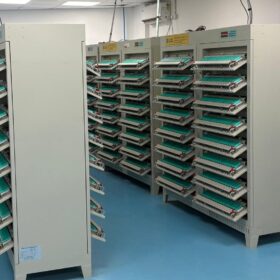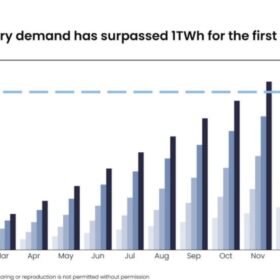Top News
The Hydrogen Stream: Ashoka Buildcon commits INR 9,000 crore investment in Bihar

Neuron Energy ties up for two-wheeler battery production

U.S. distributed generation solar panel prices decline on oversupply
Follow pv magazine now on Instagram
MediaKit 2025
pv magazine Webinar
pv magazine Webinar

Sterling and Wilson Renewable Energy secures solar project worth INR 1,200 crore

Annual lithium-ion demand surpasses 1 TWh for first time
Solarium Green gets BSE nod for SME IPO
Madhya Pradesh to meet 50% of its power needs through solar energy by 2030: Chief minister Mohan Yadav
Waaree starts solar module production at its USA facility
Markets & Policy
Featured
Global solar module prices stable-to-firm as markets wind down for year end
Antidumping investigation could more than double cost of U.S. EV battery, energy storage
Anti-dumping, countervailing duties on battery materials could have serious effects on the EV and energy storage markets, as the battery material and manufacturing markets in the U.S. are still in very early stages.
Renewable energy lending up by 60% last year
Lending to renewable energy projects in India in 2023 increased 63% year-on-year to INR 30,255 crore ($3,663 million). Out of the total, 49% went to solar projects.
ALMM cell mandate will drive up capital cost for solar developers, says Crisil report
The prices of domestically manufactured solar cells are 1.5-2 times more than alternatives from China even after basic customs duty. Such high prices can drive up the capital cost of solar power projects by INR 5-10 million/MW and, in turn, tariffs by 40-50 paise per kWh, says CRISIL Market Intelligence and Analytics.
Why district cooling is India’s best bet for climate resilience
As the need for decarbonizing cooling becomes more urgent, District Cooling delivered through the CaaS model is expected to gain wider acceptance. Its ability to scale across large developments and provide a more sustainable, long-term solution for India’s rapidly growing cooling demand positions it as a key lever to address the paradox the country faces of meeting the burgeoning cooling needs while honoring our climate commitments.
Federal Bank, Ecofy partner on financing for MSME rooftop solar
The co-lending program targets financing 3,600 kW of rooftop solar installations annually, benefiting numerous micro-, small and medium-sized enterprises (MSMEs).
Installations
How microgrids with energy storage empower remote communities
ABB to acquire Gamesa’s power electronics, storage business
ABB has agreed to purchase Gamesa’s power electronics and storage business, which produces doubly fed induction generator (DFIG) wind converters, industrial battery energy storage systems (BESS), and utility-scale solar inverters.
Acme Solar commissions 1,483 MWp in Rajasthan
Acme Solar has switched on four co-located solar projects aggregating to 1,023 MW AC (1,483 MWp) in Rajasthan. The capacity, connected to the interstate transmission system, constitutes 85% of the overall 1.2 GW project that benefits from a 25-year power purchase agreement (PPA) with SECI at a tariff of INR 2.44/kWh.
Avaada Energy wins 200 MW (DC) solar project from GUVNL
Avaada Energy will develop a 200 MW (DC) solar plant for power supply to Gujarat Urja Vikas Nigam Ltd at a tariff of INR. 2.75 per kWh.
NTPC Renewable switches on 30 MW solar in Gujarat
The newly commissioned capacity is part of NTPC Renewable Energy’s 150 MW solar project across Limbdi, Mesanka and Radhanpur
India to mandate energy storage for solar, wind projects
India is likely to follow in the footsteps of China and mandate the inclusion of battery storage capacity for future wind and solar energy projects.
Technology
Featured
Oriana Power commits INR 10,000 crore renewable energy investment in Rajasthan
Hithium unveiles 6.25 MWh BESS, sodium-ion battery cell, installation-free home microgrid
A trifecta of cutting-edge products debuted at Hithium’s second Eco Day event held in Beijing.
Five-year testing show PV façades perform better than expected
Researchers in the Netherlands have analyzed the performance of PV façades during the period 2018-2023 and have found that these system may generate more economic value than conventional rooftop PV systems. Their analysis was based on financial, technical and environmental metrics
Waaree Energies, IIT Bombay collaborate to drive perovskite solar R&D
Waaree Energies will support creation of an advanced fabrication and characterization setup for high-efficiency perovskite solar cells at IIT Bombay.
Volta Energy unveils new solar generator for construction sites, pumps
Netherlands-based Volta Energy has launched a 15 kVA portable solar generator to provide offgrid power equipment for use on construction sites. The system includes solar panels, an inverter, battery, trailer, and a backup bio-diesel generator.
Improving solar cell efficiency with upconversion nanoparticles
An international research group has developed a light upconversion system that can reportedly improve crystalline silicon solar cell efficiency by up to 0.87%. The technology consists of multilayer nanoparticles that act as near-infrared absorbers across different spectral ranges.
Manufacturing
Featured
India’s solar PV cell manufacturing capacity to reach 60 GW by FY 2027
Qcells hits 28.6% efficiency with scalable perovskite-silicon solar cell
South Korea-based solar module manufacturer Qcells has set a new efficiency world record for a commercially scalable perovskite-silicon tandem solar cell, produced at its pilot line in Germany.
Nexwafe claims 24.4% efficiency for heterojunction solar cell built with its ultrathin wafers
The German wafer manufacturer said the efficiency was achieved with an unspecified M6 HJT commercial production line, without specifying if the result was certified by an independent third party.
New US solar manufacturer to open 2.5 GW HJT factory
NuVision Solar – a newly formed, US-owned and operated manufacturer – has revealed plans to produce heterojunction (HJT) solar cells and modules.
Trump touts solar trade tariffs
While the Inflation Reduction Act (IRA) is reshoring solar manufacturing in the United States, raising import tariffs may slow momentum. The actions of the incoming Trump administration are tough to forecast at this point.
Shift to 2 kV voltage in solar projects tipped to gain traction
Amid record-low prices for solar modules, the focus of cost reduction for utility-scale solar projects is shifting to non-module balance-of-system (BoS) expenses. A transition from 1.5 kV voltage to 2 kV in solar projects is expected to gain traction through 2030.
Energy Storage
Featured
Reliance Power arm secures LoA for 930 MW solar with 465 MW/1,860 MWh battery storage
India’s green hydrogen leap presents INR 8-10 trillion opportunity
India’s target of achieving 5 million tonnes per annum of green molecule production by 2030 presents an investment opportunity of INR 8-10 trillion across building the infrastructure for electrolyzer production, renewable energy generation and green molecule production.
NTPC tenders BoS package for 1.5 GW solar in Rajasthan
NTPC Green Energy Ltd (NGEL) has tendered the balance-of-system package for 1.5 GW of grid-connected solar PV projects in Bikaner, Rajasthan.
ACME Solar secures 250 MW renewables-plus-storage project in NHPC auction
With the latest win, Acme Solar’s overall renewables portfolio has increased to around 7 GW.
The Hydrogen Stream: IGI Poseidon, Corinth Pipeworks test H2 transport pipes
IGI Poseidon has partnered with Corinth Pipeworks to test carbon-steel pipes for hydrogen transport under high pressure, while Axpo has begun building a green hydrogen plant in Switzerland to fuel vessels and other applications from 2026.
BNEF: Lithium-ion battery pack prices drop to record low of $115/kWh
Battery prices continue to tumble on the back of lower metal costs and increased scale, squeezing margins for manufacturers. Further price declines are expected over the next decade.
Opinion & Analysis
Featured
Solar wafer prices stabilize as supply rationalizes, regional policies shape production and trade
Navigating India’s solar operations and maintenance market
The sheer scale of solar installations means that ensuring consistency in operations and maintenance practices across the country is no easy task. Moreover, as technology continues to evolve, companies will need to keep up with the latest innovations to stay competitive.
Stable GPM polysilicon prices post-antidumping duty rates, optimism on firm demand
In a new weekly update for pv magazine, OPIS, a Dow Jones company, provides a quick look at the main price trends in the global PV industry.
Bolstering energy transition through green hydrogen
By offering incentives for green hydrogen production and manufacturing electrolyzers, the government of India is making it easier for players to enter this space and scale up technologies. The focus on public-private partnerships is crucial to this effort, ensuring that both the public sector and private companies collaborate efficiently to make green hydrogen a reality impacting masses.
Ensuring the success of solar installations
While solar EPC projects present immense opportunities, they also face challenges that require strategic navigation, including risk management, regulatory compliance, and stakeholder coordination.
How developing economies are leading the surge in solar power
Favorable government policies have played a crucial role in driving the adoption of solar energy in emerging economies. However, investment in grid modernisation and energy storage solutions is crucial to unlock the next level of sustainable solar integration in these economies.




